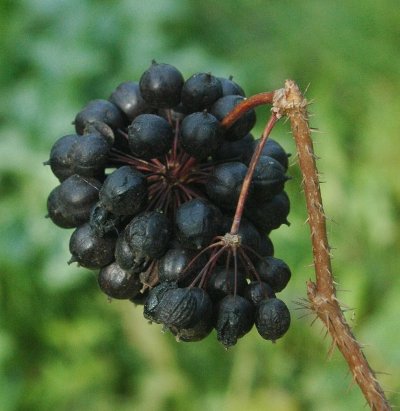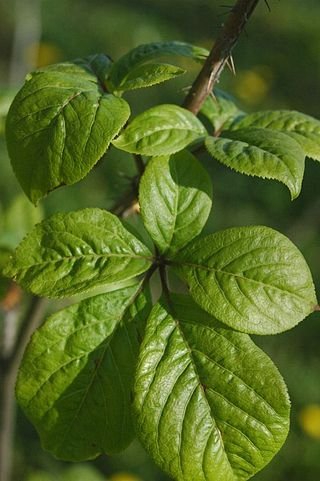Siberian Ginseng
 Common Names: Siberian ginseng, eleuthero, ciwujia, Devil’s bush or shrub
Common Names: Siberian ginseng, eleuthero, ciwujia, Devil’s bush or shrub
Scientific Name: Eleutherococcus senticosus
Climate: Moderate
Plant Description: Although Siberian ginseng is a member of the ginseng family, it is completely different to the common variety. It can grow up to three meters in height. It is a shrub that has bristles on the branches. The stems of the leaves, which grow in five lobes, also have spines. The leaves grow in clusters and are yellow if female, and blue if male although some female flowers may also be blue. The female flowers produce black berries.
Cultivation: Siberian ginseng is a very resistant shrub that grows in the wild in Eastern Siberia, Korea, China and Japan. It is native to pine and oak forests in the region. It can grow in sandy or clayey soils, and is tolerant to poor quality soils and pollution. It can thrive in direct sunlight but prefers partial shade.
The seeds of the shrub are dormant, common to hardy plants, and are difficult to germinate. To germinate them, they can be kept in moist sand or peat in very cold conditions, ideally in a refrigerator. This process is known as stratification. They should be checked every month to see if they have sprouted, which can take up to two years. They can then be transferred to small pots until they are ready for transplanting in the field. If natural conditions are right, the seeds can be planted directly to the soil, but germination can take up to two winters. They should be planted about 15 cm apart. The rhizomes can take up to five years of growth before they are ready for harvesting.
 Uses: Siberian ginseng contains chemicals that affect cognitive functioning, immunity, and some hormones. Some of the chemicals may also act against bacteria and viruses.
Uses: Siberian ginseng contains chemicals that affect cognitive functioning, immunity, and some hormones. Some of the chemicals may also act against bacteria and viruses.
The rhizomes of this plant have been used for centuries in traditional Asian medicine. There are indications that it acts as a stimulant and reduces fatigue. It has been used to improve memory and concentration. Research shows that it may have positive effects similar to common ginseng in the treatment of cancer. As it boosts the immune system, it may have healing properties for wounds and ulcers. This can also shorten the severity and length of respiratory problems such as flu and pneumonia. It reduces insulin resistance and can be used to treat diabetes.
Normal dosage is between 300 and 1,200 mg daily, taken in the morning between meals. It shouldn’t be taken for more than six weeks. It is not recommended for children, pregnant women, or people with heart or liver conditions.
Pests and Diseases: A recent study (2020) identified aphids and stink bugs as the main pests attacking Siberian ginseng, and black ring spot as the main disease that affects it.
Growing mint and garlic alongside the plant is an effective method of repelling aphids, and they can also be sprayed with soapy water or neem oil.
References:
https://www.koop-phyto.org/en/medicinal-plants/ginseng.php
https://www.richters.com/show.cgi?page=InfoSheets/d2864.html
https://www.webmd.com/vitamins/ai/ingredientmono-985/eleuthero
https://www.medicalnewstoday.com/articles/319084
https://www.gardendesign.com/how-to/aphids.html
Lee, Jae-Hong & Jeong, Haet-Nim & Kang, An-Seok & Choi, Kang-Jun. (2007). Characteristics of Major Diseases causing Eleutherococcus senticosus Max. Korean Journal of Medicinal Crop Science. 15
En español: Ginseng siberiano
